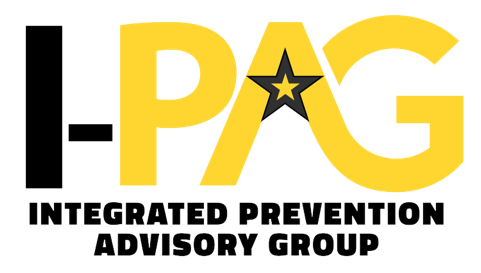
Frequently Asked Questions
Why is the Army developing an Integrated Prevention Advisory Group (I-PAG)?
The Secretary of Defense created a commission within the Department of Defense (DOD) to review the effectiveness of existing programs and policies designed to prevent and respond to sexual assault and other harmful behaviors. One of the key findings was that different parts of the current prevention system are working in silos, independent of one another. As a result, the DOD was tasked with:
- Developing a model for a dedicated, capable, credentialed prevention workforce
- Developing a professional credential for the prevention workforce
- Determining the necessary requirements for a full-time prevention workforce for the Active, Reserve and National Guard components of the military departments
- Ensuring that prevention programs and activities are evaluated through continual quality improvement
What are the Phase I and Phase II I-PAG locations?
Phase 1 I-PAG implementation will occur at the following locations:
- Fort Cavazos (formerly Fort Hood) (FORSCOM)
- Fort Riley (FORSCOM)
- Fort Sill (TRADOC)
- Hawaii (Schofield Barracks, 25th ID; USARPAC)
- South Korea (Camp Humphreys, Eighth Army; USARPAC)
Phase 2 I-PAG implementation will occur at the following locations:
- Fort Liberty (FORSCOM)
- Joint Base Lewis McCord (FORSCOM)
- Fort Bliss (FORSCOM)
- Fort Campbell (FORSCOM)
- Fort Carson (FORSCOM)
- Fort Stewart (FORSCOM)
- Fort Drum (FORSCOM)
- Fort Johnson (FORSCOM)
- Fort Irwin (FORSCOM)
- Fort Moore (TRADOC)
- Fort Leonard Wood (TRADOC)
- Fort Jackson (TRADOC)
- Fort Eisenhower (TRADOC)
- Fort Gregg-Adams (TRADOC)
- USAREC- Fort Knox (TRADOC)
- Fort Novosel (TRADOC)
- Fort Leavenworth (TRADOC)
- Fort Huachuca (TRADOC)
- Presidio of Monterey (TRADOC)
- Joint Base Langley Eustis (TRADOC)
- Grafenwoehr (USAREUR-AF)
- Stuttgart (USAREUR-AF)
- Wiesbaden (USAREUR-AF)
- Ansbach (USAREUR-AF)
- Kaiserslautern (USAREUR-AF)
- Chievres (USAREUR-AF)
- Vicenza (USAREUR-AF)
- Redstone Arsenal (AMC)
- Aberdeen Proving Ground (AMC)
- Detroit Arsenal (AMC)
- Rock Island Arsenal (AMC)
- Fort Wainwright (USARPAC)
- Camp Zama (USARPAC)
- Camp Okinawa (USARPAC)
- Joint Base Elmendorf-Richardson (USARPAC)
- Fort Meade (MDW)
- Fort Belvoir (MDW)
- Joint Base Myer-Henderson Hall (MDW)
- Army Futures Command
- ARCYBER
- Army Central Command
- Joint Base San Antonio (ARNORTH/MEDCOM)
- Carlisle Barracks (USAWC)
- US Military Academy
- INSCOM
- USASOC
- White Sands Missile Range (ATEC)
How will the I-PAG be implemented?
The I-PAG are being implemented in a phased approach. Lessons learned from each phase will be incorporated into the next phase. The Army is currently implementing Phase II of the I-PAG and is hiring for Supervisory Prevention Specialists (Prevention Leads), which will be followed by hiring for Prevention Specialists (Prevention Deputies).
What capability will the I-PAG provide that doesn’t already exist?
This advisory group will be solely dedicated to building an integrated prevention system that establishes policies and practices to support leaders in their duty to increase protective factors and reduce risk factors that contribute to sexual harassment, sexual assault, child abuse and domestic abuse/intimate partner violence, self-harm, and workplace violence.”
How many people will make up the I-PAG?
The I-PAG is currently in Phase II of implementation….
What types of roles/functions will members of the I-PAG have?
The majority of I-PAG staff at HQDA and Army Command levels will be directly responsible for building the system and infrastructure to support the prevention capability. I-PAG personnel will conduct surveillance, collect data and use evidence-based/peer-reviewed research to determine which effective primary prevention activities would complement the military environment. Commanders will use this information and data to inform policy and guidance. Most I-PAG staff members will lead the planning, implementation and evaluation of primary prevention activities for two or more harmful behaviors (for example: sexual harassment, sexual assault, child abuse, child sexual abuse, death by suicide, domestic/intimate partner violence, workplace violence and discrimination).
Will personnel in the I-PAG displace currently serving civilian and military personnel?
No. The prevention workforce will be added to the existing encumbered authorizations. The Army, however, conducted information-gathering sessions and a staffing analysis survey to determine if there are personnel with skills and experience that make them suitable for transfer into the prevention workforce. Individuals with the appropriate skill sets, knowledge and experience can compete for I-PAG positions.
